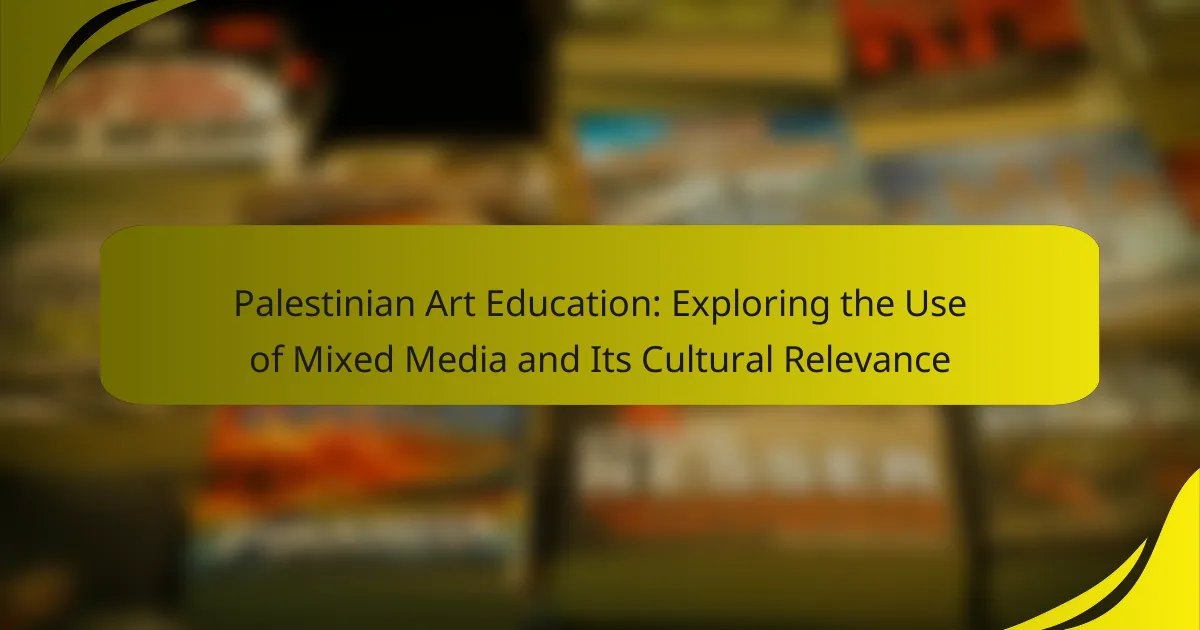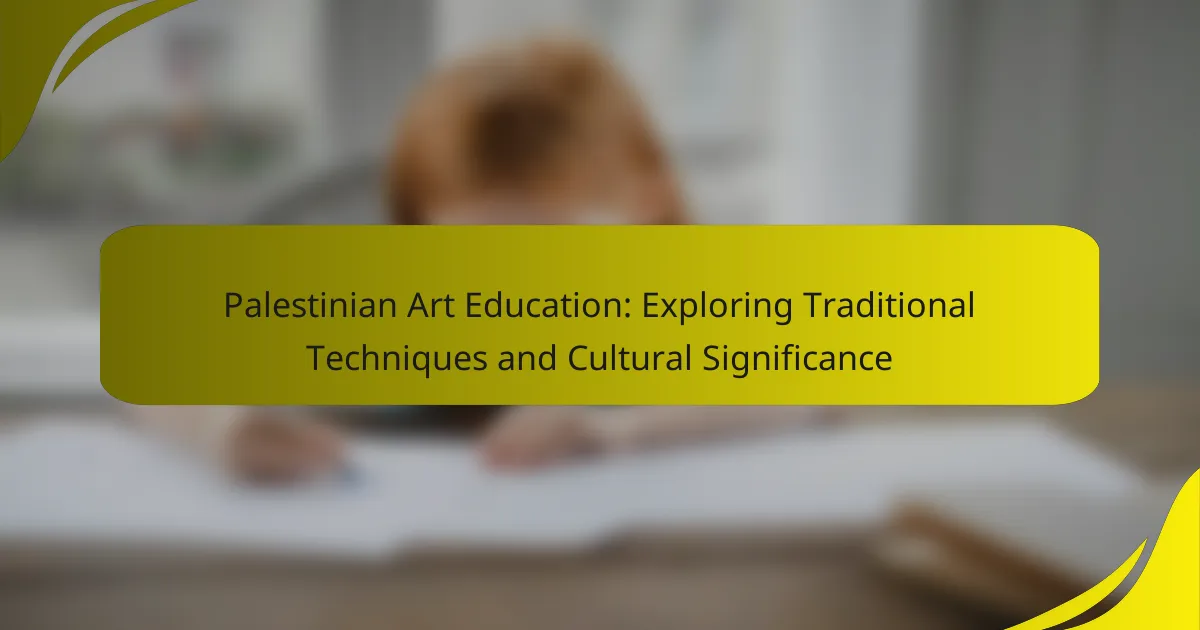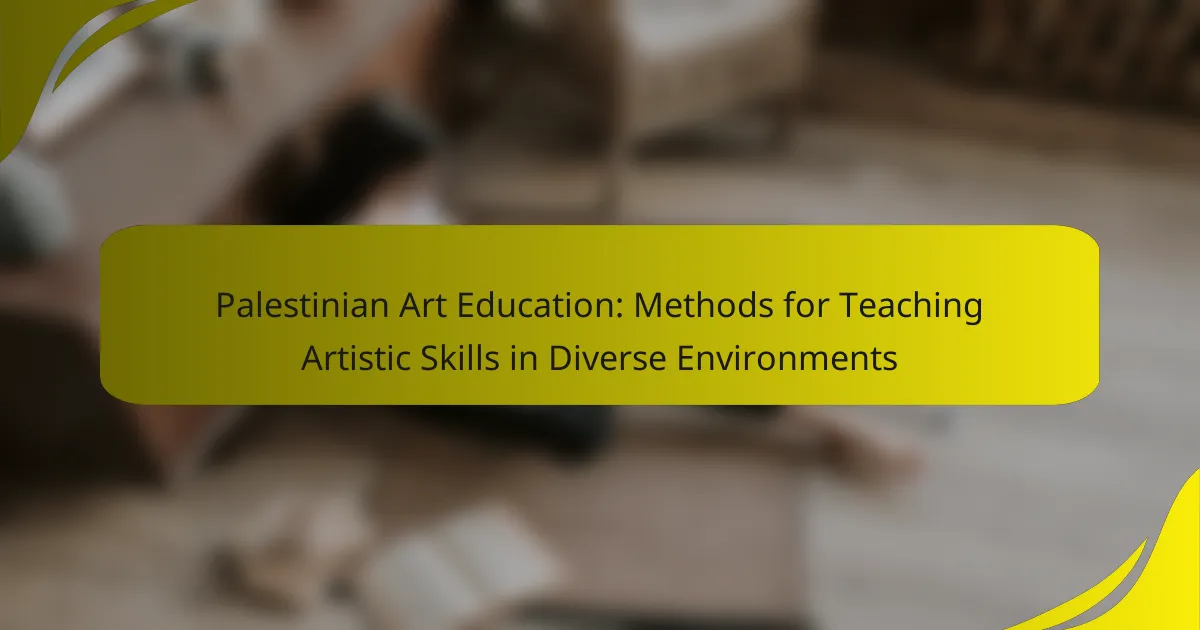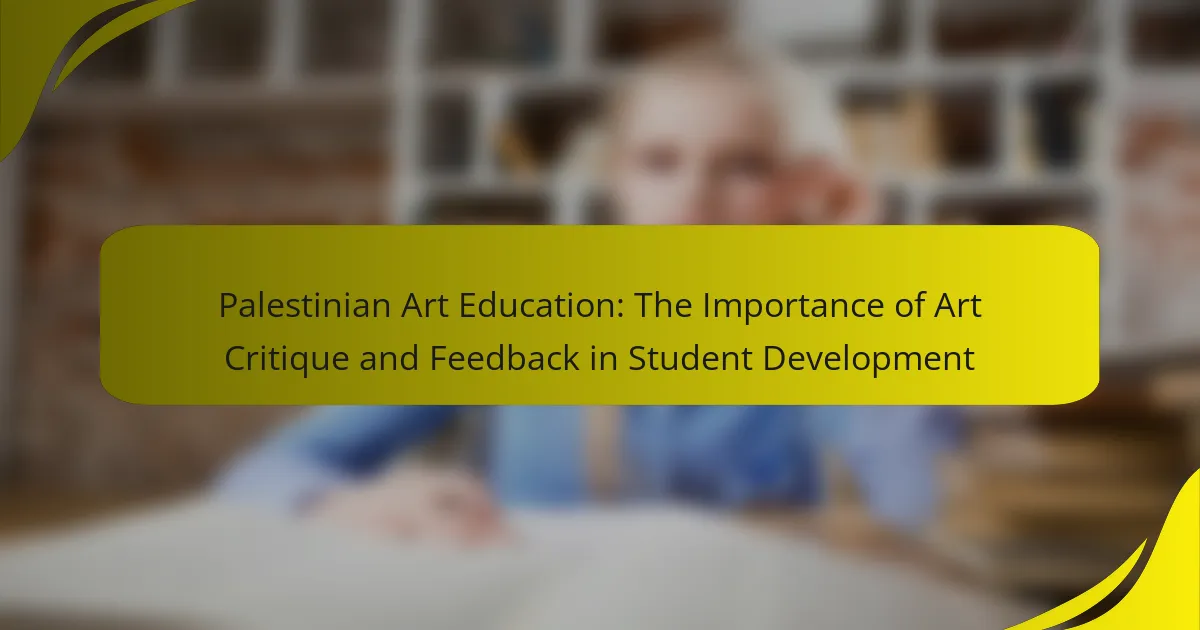Palestinian Art Education encompasses the systematic teaching and learning of various artistic expressions, including visual arts, music, and literature, within Palestinian communities. This educational framework aims to nurture creativity and cultural identity, while also addressing the historical and political context of Palestine, which significantly influences artistic themes. Key organizations, such as the International Academy of Art Palestine, play a vital role in providing resources and support for aspiring artists. Despite facing challenges like political instability, limited resources, and cultural censorship, Palestinian art education emphasizes the importance of heritage and resistance, integrating traditional art forms and contemporary practices to foster a deeper understanding of the Palestinian narrative.
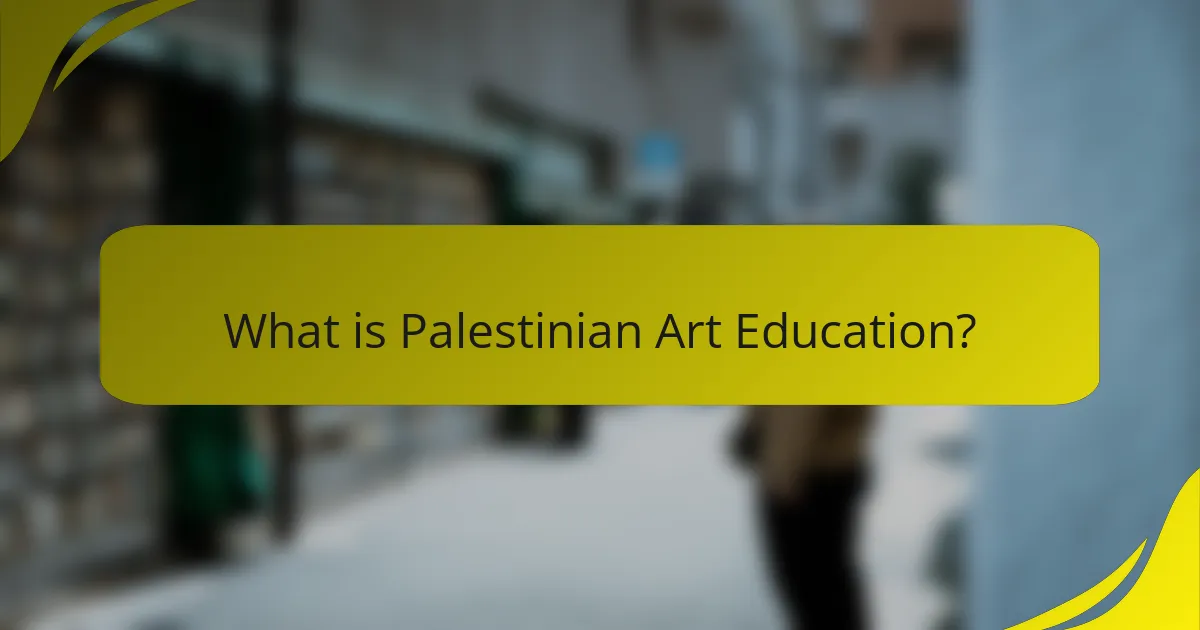
What is Palestinian Art Education?
Palestinian Art Education refers to the systematic teaching and learning of art within Palestinian communities. It encompasses various forms of artistic expression, including visual arts, music, and literature. This education aims to foster creativity and cultural identity among Palestinians. It also addresses the historical and political context of Palestine, influencing artistic themes and practices. Institutions and programs often emphasize the importance of heritage and resistance in art. The curriculum may include traditional techniques alongside contemporary methods. Notable organizations, such as the International Academy of Art Palestine, play a key role in this educational landscape. They provide resources and support for aspiring artists to express their narratives.
How has historical context shaped Palestinian Art Education?
Historical context has significantly shaped Palestinian Art Education through various social and political influences. The ongoing Israeli-Palestinian conflict has profoundly impacted artistic expression and education in Palestine. This conflict has led to a focus on themes of identity, resistance, and cultural heritage in artistic curricula.
The establishment of institutions like the International Academy of Art Palestine in 2006 reflects a response to these historical challenges. These institutions aim to preserve Palestinian cultural narratives and promote artistic skills amidst adversity. Additionally, historical events such as the Nakba in 1948 and subsequent displacements have influenced the content and focus of art education.
Art education in Palestine often incorporates traditional forms and contemporary practices to address social issues. This blend helps students explore their identity and express their experiences. The historical context has also fostered a sense of community and solidarity among artists and educators.
Thus, the historical context has not only shaped the content of Palestinian Art Education but has also influenced its methods and objectives, making it a vital tool for cultural expression and resilience.
What key historical events influenced the development of Palestinian Art Education?
The key historical events influencing the development of Palestinian Art Education include the Nakba in 1948 and the subsequent Israeli occupation. The Nakba led to the displacement of Palestinian people and a significant cultural loss. This event sparked a need for preserving Palestinian identity through art.
The establishment of the Palestine Liberation Organization (PLO) in 1964 also played a crucial role. The PLO promoted cultural initiatives, including art education, as a means of national expression. The First Intifada in 1987 further emphasized the role of art in resistance and identity.
In recent years, the establishment of art institutions, such as the International Academy of Art Palestine in 2006, has formalized art education. These events collectively shaped the curriculum and focus of Palestinian Art Education, integrating themes of identity, resistance, and heritage.
How do cultural traditions impact artistic expression in Palestinian Art Education?
Cultural traditions significantly influence artistic expression in Palestinian Art Education. These traditions shape the themes, techniques, and materials used by artists. For instance, traditional motifs and symbols often reflect Palestinian identity and heritage. Additionally, storytelling and oral traditions inform the narratives depicted in artworks. The integration of folk art practices highlights communal values and historical experiences. Furthermore, art education incorporates these cultural elements to foster a deeper understanding of identity among students. Research indicates that engaging with cultural traditions enhances creativity and personal expression in young artists. This connection to heritage is crucial for preserving Palestinian culture amid external influences.
What are the primary objectives of Palestinian Art Education?
The primary objectives of Palestinian Art Education are to foster cultural identity and promote artistic expression. This education aims to empower students by providing them with tools to explore their heritage. It encourages critical thinking through the analysis of historical and contemporary art. Palestinian Art Education also seeks to develop skills that enable students to communicate their experiences. Additionally, it aims to raise awareness of social and political issues through artistic practices. By integrating local and global art contexts, it enhances students’ understanding of their place in the world. This approach nurtures creativity and innovation among young artists. Ultimately, it supports the preservation and evolution of Palestinian cultural narratives.
How does Palestinian Art Education promote cultural identity?
Palestinian Art Education promotes cultural identity by fostering a connection to heritage and history. It encourages students to explore and express their cultural narratives through various art forms. This education emphasizes traditional techniques and themes that reflect Palestinian life and struggles. Workshops and community projects often incorporate local stories and symbols. By engaging with these elements, students develop a sense of belonging and pride in their identity. Research indicates that art education can enhance cultural awareness and self-expression among youth. Programs often showcase works that highlight the Palestinian experience, reinforcing collective identity.
What role does artistic expression play in social and political commentary?
Artistic expression serves as a vital medium for social and political commentary. It allows artists to convey messages about societal issues and injustices. Through various forms, such as painting, music, and theater, artists can critique political systems and raise awareness. For example, Palestinian artists often use their work to reflect on the impact of conflict and occupation. This artistic output can mobilize communities and inspire activism. Historically, movements like Dada and Surrealism emerged as responses to war and oppression. Thus, artistic expression plays a crucial role in shaping public discourse and influencing change.
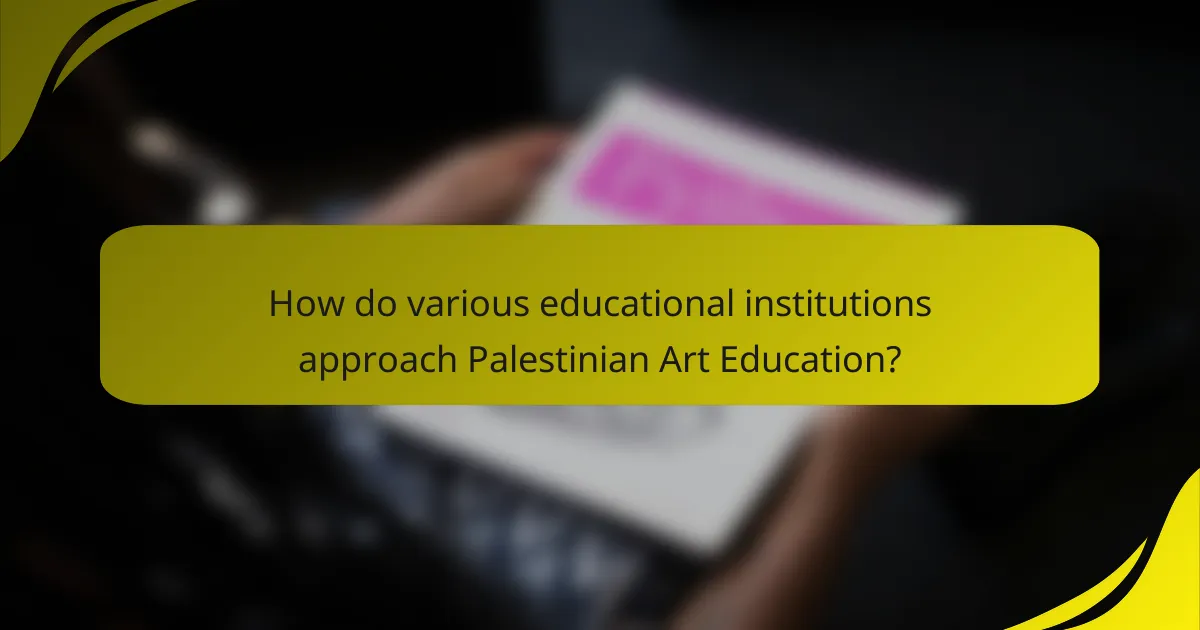
How do various educational institutions approach Palestinian Art Education?
Various educational institutions approach Palestinian Art Education by integrating cultural identity and historical context into their curricula. They emphasize the significance of art as a medium for expressing resistance and resilience. Institutions often incorporate traditional Palestinian art forms, such as embroidery and calligraphy, into their programs. They also provide platforms for contemporary Palestinian artists to showcase their work. Collaborative projects with international art organizations are common, enhancing exposure and dialogue. Additionally, some institutions focus on art therapy as a means of healing within the community. This multifaceted approach fosters a deeper understanding of the Palestinian narrative through artistic expression.
What types of institutions offer Palestinian Art Education?
Palestinian Art Education is offered by various types of institutions. These include universities that have dedicated art programs, such as Birzeit University and An-Najah National University. Art schools specifically focused on visual arts, like the International Academy of Art Palestine, also provide education. Cultural centers, including the Palestinian Cultural Palace, often host art workshops and classes. Community organizations play a role by offering art education to youth and local artists. Additionally, NGOs focused on cultural preservation contribute to art education initiatives. These institutions collectively foster artistic expression within the Palestinian context.
How do universities and art schools differ in their approach to teaching Palestinian art?
Universities and art schools differ significantly in their approach to teaching Palestinian art. Universities often emphasize theoretical frameworks and historical contexts. They may integrate Palestinian art within broader art history courses. This can sometimes lead to a more academic and less hands-on approach.
Art schools, on the other hand, focus on practical skills and personal expression. They encourage students to engage directly with Palestinian culture through workshops and studio practice. This experiential learning fosters a more intimate understanding of the art form.
Additionally, art schools may prioritize contemporary practices and community engagement. They often collaborate with local artists and organizations. This connection to the community can enhance the relevance of the art being taught.
In contrast, universities may offer more resources for research and critical analysis. They might provide access to archives and scholarly materials on Palestinian art. Both institutions aim to educate, but their methods and emphases differ markedly.
What community programs support Palestinian Art Education?
Community programs that support Palestinian Art Education include the Al-Qattan Foundation, which offers workshops and grants for artists. The Palestinian Museum promotes cultural education through exhibitions and art programs. The Art Academy of Palestine provides formal training in various artistic disciplines. Additionally, grassroots initiatives like the Palestinian Youth Art Initiative focus on engaging youth in creative expression. These programs aim to foster artistic talent and preserve cultural heritage. They often collaborate with international organizations to enhance their impact.
What methodologies are employed in Palestinian Art Education?
Palestinian art education employs various methodologies including experiential learning, community engagement, and critical pedagogy. Experiential learning allows students to explore their cultural identity through hands-on art projects. Community engagement fosters collaboration with local artists and organizations, enriching the educational experience. Critical pedagogy encourages students to analyze social and political issues through their art. These methodologies reflect the historical context of Palestine, emphasizing resilience and cultural expression. Evidence of these methodologies can be found in programs like the International Academy of Art Palestine, which integrates local history into the curriculum.
How do traditional and contemporary methods coexist in teaching?
Traditional and contemporary methods coexist in teaching by integrating established pedagogical practices with modern educational technologies. Traditional methods often emphasize direct instruction, memorization, and structured learning environments. Contemporary methods focus on student-centered learning, collaboration, and the use of digital tools.
In Palestinian art education, traditional techniques such as calligraphy and pottery are taught alongside contemporary practices like digital art and multimedia projects. This coexistence allows students to appreciate their cultural heritage while engaging with global artistic trends.
Research shows that blending these methods enhances creativity and critical thinking skills. A study by Al-Harithy (2020) highlights that students exposed to both traditional and contemporary approaches demonstrate greater artistic versatility. This evidence supports the effectiveness of a dual approach in fostering a comprehensive art education.
What innovative practices are being implemented in Palestinian Art Education?
Innovative practices in Palestinian Art Education include community-based art projects and digital platforms for expression. These projects engage students in real-world issues. They often incorporate local history and cultural heritage into the curriculum. Collaborative workshops with international artists are also common. This exposure broadens students’ perspectives and techniques. Additionally, art education programs emphasize critical thinking and social commentary. They encourage students to reflect on their identity and environment through art. These practices aim to empower students and foster resilience in challenging contexts.

What challenges does Palestinian Art Education face?
Palestinian art education faces significant challenges due to political instability and limited resources. The ongoing conflict restricts access to quality educational facilities. Many art educators lack formal training, impacting the quality of instruction. Cultural censorship inhibits artistic expression and creativity among students. Economic constraints limit the availability of art supplies and materials. Additionally, the lack of support from governmental institutions hampers the development of art programs. These factors collectively hinder the growth and sustainability of art education in Palestine.
How do political and social factors influence Palestinian Art Education?
Political and social factors significantly influence Palestinian Art Education. The ongoing conflict and occupation have shaped the themes and expressions in Palestinian art. Artists often reflect their realities, using art as a form of resistance and identity preservation. Social issues such as displacement and cultural heritage are central to their work. Educational institutions face challenges due to limited resources and political restrictions. These factors affect curriculum development and access to artistic materials. Additionally, the political climate can foster a sense of urgency in artistic expression. Events like the Gaza War have directly impacted art education initiatives. Overall, these influences create a unique landscape for Palestinian artists and educators.
What barriers do artists encounter in expressing their work?
Artists encounter various barriers in expressing their work, particularly in the context of Palestinian art. These barriers include political restrictions that limit freedom of expression. Economic constraints often hinder access to materials and resources needed for artistic creation. Cultural norms can impose limitations on the themes and subjects artists can explore. Additionally, social pressures may discourage artists from addressing controversial topics. The ongoing conflict in the region creates an environment of instability, affecting artists’ ability to showcase their work. Historical context plays a significant role in shaping these barriers, influencing the narratives artists can present. These challenges impact not only individual artists but also the broader artistic community in Palestine.
How does access to resources affect the quality of art education?
Access to resources significantly impacts the quality of art education. Adequate resources include materials, facilities, and trained instructors. These resources enable students to explore various artistic techniques. Limited access can hinder creativity and skill development. For example, schools with insufficient art supplies often see lower student engagement. Research shows that well-resourced programs lead to higher student achievement in the arts. A study by the National Endowment for the Arts found that students with access to quality art education perform better academically. Thus, resource availability is crucial for fostering effective art education.
What opportunities exist for growth in Palestinian Art Education?
Opportunities for growth in Palestinian Art Education include increased international collaboration and funding. Partnerships with global art institutions can enhance resources and exposure. Local community engagement can foster grassroots support for art programs. Digital platforms can expand access to art education. Workshops and mentorship programs can connect emerging artists with established professionals. Government initiatives can provide grants for art education projects. Cultural exchange programs can introduce diverse perspectives. Increased awareness of Palestinian art can attract tourism and investment in local art scenes.
How can international collaborations enhance Palestinian Art Education?
International collaborations can enhance Palestinian Art Education by providing access to diverse artistic perspectives and techniques. These collaborations facilitate knowledge exchange between Palestinian artists and international educators. They can introduce new methodologies and practices that enrich the local curriculum. Additionally, partnerships with global institutions can offer workshops and exhibitions that raise awareness of Palestinian art. This exposure can lead to increased funding and resources for art programs. For instance, initiatives like the “Palestinian Art and Culture Program” have successfully connected local artists with international mentors. Such collaborations can also foster a sense of community and support among artists facing similar challenges worldwide. Overall, international collaborations play a crucial role in expanding the horizons of Palestinian Art Education.
What role does technology play in the evolution of Palestinian Art Education?
Technology plays a significant role in the evolution of Palestinian Art Education. It facilitates access to diverse artistic resources and global art movements. Digital platforms allow students and educators to share and showcase their work widely. Online courses and tutorials provide alternative learning opportunities for aspiring artists. Technology enables collaboration among artists across geographical boundaries. Virtual exhibitions and social media amplify Palestinian voices in the art community. Furthermore, multimedia tools enhance creative expression and experimentation in art practices. The integration of technology helps preserve and promote Palestinian cultural heritage through digital archiving.
What best practices can enhance the effectiveness of Palestinian Art Education?
Integrating community involvement enhances the effectiveness of Palestinian Art Education. Engaging local artists fosters a connection between students and their cultural heritage. Incorporating historical context into the curriculum deepens students’ understanding of their artistic expression. Providing access to diverse art forms promotes creativity and critical thinking. Utilizing technology in teaching methods can expand learning opportunities. Creating collaborative projects encourages teamwork and communication skills. Offering exhibitions and public displays of student work boosts confidence and recognition. Continuous professional development for educators ensures they remain informed about contemporary practices and challenges in art education.
How can educators incorporate local history and culture into the curriculum?
Educators can incorporate local history and culture into the curriculum by integrating relevant historical events and cultural practices into lesson plans. This can be achieved through the inclusion of local artists and their works in art education. For example, Palestinian artists often reflect their cultural heritage and historical context in their artwork. Educators can analyze these works alongside historical events to provide students with a deeper understanding of their significance. Additionally, field trips to local museums or cultural sites can enhance students’ appreciation of their heritage. Engaging students in community projects that celebrate local traditions can also foster a connection to their culture. These methods help students relate their learning to their own identities and communities.
What strategies can be employed to foster creativity among students?
Encouraging creativity among students can be achieved through various strategies. One effective strategy is to incorporate project-based learning. This method allows students to engage in hands-on activities that stimulate innovative thinking. Collaborative group work can also enhance creativity. Working with peers fosters idea exchange and diverse perspectives.
Another strategy is to provide a safe space for experimentation. When students feel secure, they are more likely to take risks with their ideas. Integrating arts into the curriculum can also inspire creative expression. Subjects like music, visual arts, and drama allow students to explore their creativity in different forms.
Additionally, encouraging open-ended questions can spark creative thinking. These types of questions prompt students to think critically and explore multiple solutions. Offering choices in assignments can also promote creativity. When students have the freedom to choose, they are more invested in their work.
Finally, incorporating technology can enhance creative opportunities. Digital tools allow for innovative expression and collaboration. Research indicates that these strategies can significantly improve students’ creative skills and engagement in learning.
Palestinian Art Education is a systematic approach to teaching and learning art within Palestinian communities, encompassing various forms of artistic expression such as visual arts, music, and literature. The article examines how historical context, particularly the Israeli-Palestinian conflict, has shaped the curriculum and artistic practices, emphasizing themes of identity, resistance, and cultural heritage. It highlights the role of institutions like the International Academy of Art Palestine and community programs in promoting artistic skills and preserving cultural narratives. Additionally, the article explores the impact of cultural traditions on artistic expression, the challenges faced by artists, and the methodologies employed in art education, providing a comprehensive overview of the intersection between history and creativity in Palestinian art.
